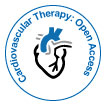Did the Coexistence of a Pacemaker Probe, a Prominent Eustachian Valve and Induced Hypothermia Lead to Severe Pulmonary Embolism in a Resuscitated Patient after STEMI?
Received Date: Feb 28, 2017 / Accepted Date: Mar 03, 2017 / Published Date: Mar 25, 2017
Abstract
Post-cardiac arrest care is a particular interesting field and often depends on individual patient characteristics. Here we present the case of a patient with ST-elevation myocardial infarction, who developed severe pulmonary embolism originating from the proximity of a prominent Eustachian valve and the introduced pacemaker probe after targeted temperature management.
Keywords: Resuscitation; Post-cardiacarrest care; STEMI; Hypothermia; Pulmonaryembolism
Citation: Schach C, Brünnler T, Luchner A (2017) Did the Coexistence of a Pacemaker Probe, a Prominent Eustachian Valve and Induced Hypothermia Lead to Severe Pulmonary Embolism in a Resuscitated Patient after STEMI? Cardiovasc Ther 2: 116.
Copyright: © 2017 Schach C, et al. This is an open-access article distributed under the terms of the Creative Commons Attribution License, which permits unrestricted use, distribution, and reproduction in any medium, provided the original author and source are credited.
Share This Article
Open Access Journals
Article Usage
- Total views: 3796
- [From(publication date): 0-2017 - Nov 27, 2024]
- Breakdown by view type
- HTML page views: 3077
- PDF downloads: 719
